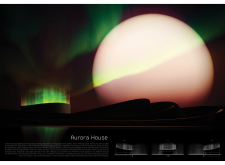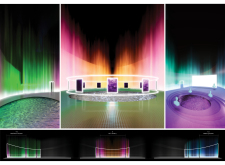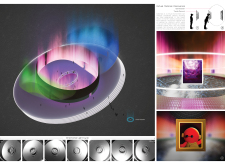5 key facts about this project
The structure is organized into three primary zones: a Meeting Space, an NFT Gallery, and a Meditation Space. Each zone is designed to facilitate specific functions while promoting a sense of interconnectedness among users. The spatial layout encourages movement and interaction, allowing occupants to navigate the space fluidly.
The architecture of Aurora House exhibits unique design approaches by integrating responsive elements that alter based on user engagement and external environmental conditions. This adaptability is achieved through mathematical algorithms that dictate the behavior of architectural components, allowing the space to reshape itself in response to the occupants' movements. The design processes focus on creating an environment that responds to human presence rather than one that is static.
Materiality plays a significant role in the design of Aurora House. The project incorporates innovative materials, including Seen/Unseen and Purple Mercury, which enhance the sensory experience. The use of these materials facilitates an engaging and interactive atmosphere, where light and color dynamically modify to create different moods and settings. This approach not only emphasizes the project's aesthetic quality but also underlines its unique conceptual foundation rooted in the experience of the auroras, translating natural beauty into an architectural context.
The integration of technology within Aurora House is another defining characteristic. Advanced lighting systems and digital interfaces are employed to provide real-time user interaction and feedback. Each space is equipped with systems designed to enhance occupant experience through tailored lighting schemes, reinforcing the connection between functionality and architectural expression. The architectural plans and sections reflect this integration, illustrating the thoughtful organization of spaces and the innovation embedded in the construction process.
For a comprehensive understanding of Aurora House and its architectural significance, viewers are encouraged to explore the detailed architectural designs and drawings. Reviewing the architectural plans and sections will provide further insights into how the project addresses contemporary design challenges and enhances user interaction in spatial environments.


























